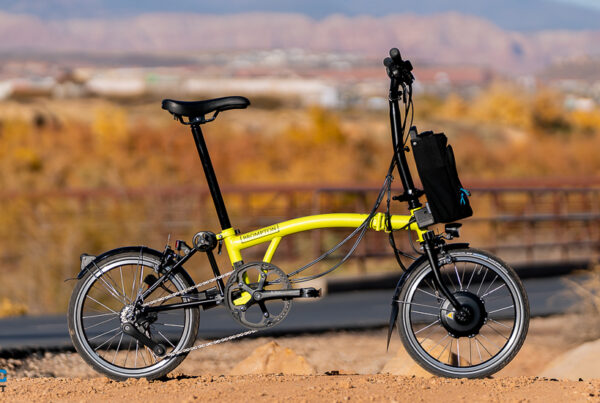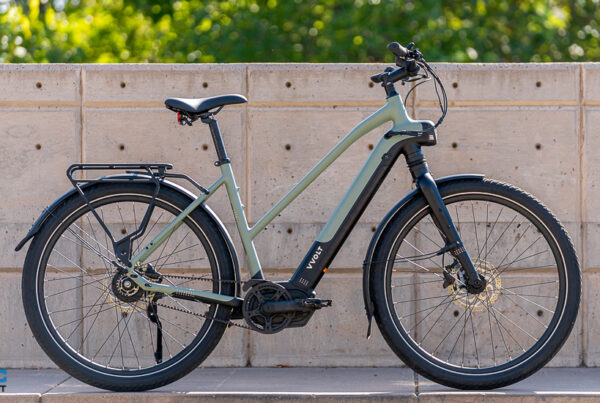When discussing the Galaxy SL’s ride comfort, a significant caveat is that so much comes down to personal preference. For various reasons, comfort was the area I had the greatest number of concerns with regarding the bike, but my comments should certainly be taken with a grain of salt. My points of critique may not overlap with everyone. Fortunately, I am able to consult my fellow reviewers for their input, so I will try to offer a consensus or at least point out when I am not.
For example, my height exceeds that of the bike’s recommended range, but just barely. In fact, all but one of our testers measure at or above the SL’s recommended height limit. The Galaxy SL is designed to fit riders between 4’10” and 5’10”, so with my height of 5’11”, the bike did seem a little small to me. One of our other reviewers who sits on the lower end of the SL’s height range felt differently, though; she found the frame to be comfortable and sized correctly. For weight purposes, which I discussed previously, the frame size and subsequent rider height range makes sense. This smaller size helps to keep the bike’s weight down, which gives it the ability to be lifted or transported more easily.
In line with its beach cruiser styling, the Galaxy SL features swept-back handlebars for a casual riding experience. Personally, I am not the biggest fan of this style due to my previously mentioned wrist issues, but they are generally OK for shorter rides, and I understand the appeal. Our other testers had no issues with the shape. While I prefer an ergonomic shape somewhere between cruiser-style and flat handlebar design, I did still appreciate some of the features included on the SL. The bike’s ergonomic rubber grips were comfortable, and its relatively compact cockpit layout ensured that all of the included controls were easy to reach without straying far from them.
The Galaxy SL’s left handlebar hosts a throttle lever, brake lever, and the bike’s controller, while the right side accommodates the twist shifter and other brake lever. As is common with e-bikes, the full-color LCD display is mounted centrally over the stem. It’s a simple, effective layout, with the only additional thing we’d like to see included being a bell (which would be another safety benefit and only add to the bike’s cruiser styling). Fortunately, that accessory is inexpensive and easy to add after the fact.
I have discussed the brakes and twist shifter in previous sections (the throttle lever is standard and unnecessary to discuss further), but I want to elaborate a bit more about the Galaxy SL’s user interface, its control pad and display. Overall, the interface felt a bit dated in our contemporary world of smartphones with less tactile , but that critique is minor when considering its benefits. In contrast with many e-bikes outfitted with small control pads and rubberized buttons arranged tightly together, the Galaxy SL’s pad is large, made of hard plastic, and clicky. The size and layout makes the buttons themselves easy to read and easy to accurately hit, while the clicks give a clear signal that you’ve activated one. Curiously, the bike we received for testing had a different display than the one shown on the Galaxy SL’s webpage (at the time of writing). While the version shown there displays a clean, easy to read arrangement of metrics, the one on our test bike felt a bit busy to me and took some time to adjust to. It was fine after I learned where to look for the information I wanted to reference, though I admit I would personally prefer the more simplified design. I reached out to Evelo for clarification regarding the difference in displays, and was told that we received the newest, most updated version, while the website hasn’t quite caught up (again, at time of writing).
With the Galaxy SL’s technological features and controls covered, let us dive into the riding experience itself. As I mentioned, the SL’s mid-drive motor gives it the feel of a more traditional non-electric bike. Its 24” wheels are a nice compromise between 20” and 26” wheels, making the bike feel nimble and highly maneuverable, in addition to reducing size and weight. They are certainly a less common size, however, and may not be as easy to find replacements for.
Another feature to discuss is the Galaxy SL’s saddle. Its styling and color add to the bike’s classic design, and certainly enhance its visual appeal. That said, I personally found it to feel pretty hard after only about 20 minutes on the bike, and our other testers agreed. I think the old-school saddle that this one is trying to emulate would feel similarly (or even more) firm, so it shouldn’t come as a surprise, but if you’re looking for a more comfortable ride, I would consider looking into Evelo’s list of accessories. Fortunately, they offer multiples of both padded saddle and suspension seatpost options.
One final note regarding the fenders. I appreciate seeing fenders included on a bike where appropriate, and the Galaxy SL is one of those cases. Thanks to some recent rainy weather locally, I was able to put the bike’s fenders to the test. Overall, they did a fairly good job of keeping my pants dry, though I did end up with a few spots from splashes. That was expected considering the SL’s slim fender design, but it’s worth pointing out that they were not quite as effective as wide, full coverage fenders would be.
Source link








